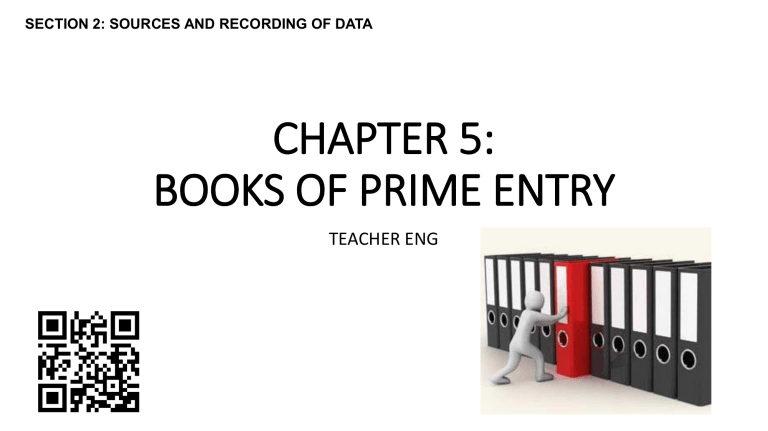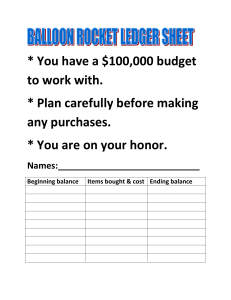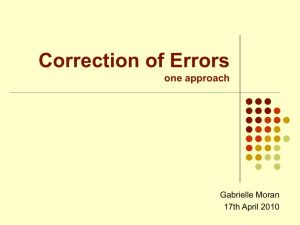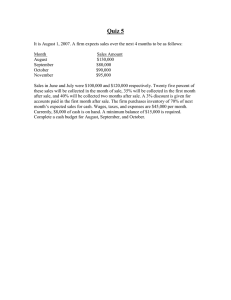
SECTION 2: SOURCES AND RECORDING OF DATA CHAPTER 5: BOOKS OF PRIME ENTRY TEACHER ENG ADVANTAGE OF USING BOOKS OF PRIME ENTRY • A book of prime entry is a book where transactions are first listed in date order. These entries are later posted to ledger accounts, using the double entry system of book-keeping. • The advantages of using books of prime entry can be briefly summarised as follows: » They prevent the accounts in the nominal (general) ledger from being overcrowded. » They are a quicker way to record transactions. » There are fewer errors. ADVANTAGE OF USING BOOKS OF PRIME ENTRY The books of prime entry are: » the cash book » the petty cash book » the sales journal » the sales returns journal (or returns inwards journal) » the purchases journal » the purchases returns journal (or returns outwards journal) » the general journal. TRADE DISCOUNTS AND CASH DISCOUNTS • A cash discount is a discount given to customers for prompt payment. Cash discounts are included in the profit and loss section of the income statement • Discounts received are cash discounts allowed by a supplier to a business when payment is made within the qualifying period. It is an income. • Discounts allowed are cash discounts given to a customer by a business for prompt payment. It is an expense incurred by the business for having its debts settled promptly. • A trade discount, which is shown as a deduction on the list price in an invoice, is not documented in accounting records. A trade discount is given to customers who buy in bulk. USE OF ACCOUNTING DATA IN BOOKS OF PRIME ENTRY a) CASH BOOK • The cash and bank accounts are shown together side-by-side in the cash book. • The cash book has a dual function – it is a book of prime entry and also a ledger account for bank and cash. USE OF ACCOUNTING DATA IN BOOKS OF PRIME ENTRY i) Debit side of the two-column cash book The debit side of the two-column cash book is used to record receipts. Money added to the business cash till will be entered in the cash column. Bank deposits will be recorded in the bank column. Bank deposits could be: » cheques paid into the bank » bank transfers/credit transfers – a simple and convenient way for trade receivables to pay the business by directly transferring money into the business’ account. These funds are electronically transferred, using internet banking. USE OF ACCOUNTING DATA IN BOOKS OF PRIME ENTRY ii) Credit side of the two-column cash book Any payments made by cash taken out of the business cash till or cash box are recorded in the cash column on the credit side. Similarly, bank withdrawals will be recorded on the credit side in the bank column. Bank withdrawals could be: » Cheques made out to business trade payables » direct debits – these represent an arrangement by a business with its bank for a creditor to transfer money from the business’ account on pre-arranged dates. Businesses usually pay their electricity and other bills this way » standing orders – these represent instructions to the business’ bank to transfer a set amount from the business’ account into that of a creditor at regular intervals. USE OF ACCOUNTING DATA IN BOOKS OF PRIME ENTRY iii) Contra entries Appear on both sides of the cash book, as explained below. Cash from the business’ cash till paid into the business’ bank account debit bank and credit cash. Cash withdrawn from a business’ bank account for business use the cash account will be debited and the bank account credited. Surplus cash paid into the bank account The entries to be made in the cash book are debit the bank column of the cash book and credit the cash!column. TWO-COLUMN CASH BOOK WORKED EXAMPLE 1 For April 2018, these cash and bank transactions are made. 1 April Balances are as follows: Cash in hand $102, Cash in bank $1190 8 April Payment of $200 by cheque to Emma 10 April Cash sales of $89 paid for by cheque 12 April Cheque received from Kashi for $315 15 April Cash paid for advertising $95 19 April Cash amount of $45 withdrawn from bank for business use 23 April Payment of $178 by cheque to Jayden 28 April Electronic transfer made from business bank of $100 to NW Electricity Ltd Balance the cash book at the end of the month, stating the closing balances. TWO-COLUMN CASH BOOK 2018 Cash $ Cash Book Bank $ 2018 Cash $ Bank $ BANK OVERDRAFT • An overdraft is a type of short-term loan that a bank gives its customers upon request. • In this instance,the business can withdraw more than it has deposited in the bank, resulting in the business having a credit balance in its bank account (in the cash book). DISHONOURED CHEQUE • Dishonoured cheque is a cheque that has been rejected for payment when deposited in the bank. • Bank account is credited and the debtor’s account debited with the amount of the cheque. This entry reverses the original entry. • The most common reason why a cheque is dishonoured is because there are insufficient funds in the drawer’s account to pay the cheque. Other reasons include: » irregular signature – the signature on the cheque does not match the specimen signature held by the bank » alterations – an alteration is made, even if the alteration is initialed » the cheque is presented before the date on the cheque. For example, a cheque bearing a date of 17 July, but written on 2 July is a post-dated cheque. This cheque will be dishonoured if presented before 17 July » the cheque is stale if it is more than six months old » the drawer has stopped payment on the cheque » the amount in words differs from the amount in figures shown on the cheque. THREE-COLUMN CASH BOOK WORKED EXAMPLE 2 For April 2018, the following cash and bank transactions are made. 1 April Balances brought forward: Cash $175, Bank $290 overdrawn 3 April Paid Ling by cheque $400 in full settlement of $420 owing 8 April Paid $50 cash into bank account 15 April Received cheque from Cheng for $250 in full settlement of sale for $275 22 April Received cheque of $90 from Hosna in settlement of sales worth $95 25 April Cash withdrawn from bank for business use $30 29 April Paid Kalim by bank transfer $210 in full settlement of sales invoice totalling $225 Balance the cash book at the end of the month, stating the closing balances. THREE-COLUMN CASH BOOK 2018 Discounts $ Cash Book Cash Bank $ $ Discounts 2018 $ Cash $ Bank $ b) ANALYTICAL PETTY CASH BOOK • A petty cash book is used to record low-value cash transactions such as petrol charges, cleaning expenses and postage stamps. • An imprest or float is a fixed amount of money with which the petty cashier starts an accounting period. • A petty cash voucher is a document showing the purpose for which the money is required and the date. It is signed by the person making a claim for cash for an expense. b) ANALYTICAL PETTY CASH BOOK How to make entries in a petty cash book: » When the float is received at the start of the accounting period – an entry is made on the debit side of the petty cash book. » When expenses are recorded during the accounting period – every payment made is entered twice: first in the total column and then in the appropriate expense column. » When receipts are recorded during the accounting period – small payments received by the petty cashier during the accounting period are entered on the debit side of the petty cash book and the account to be credited is entered in the details column. » When totals are made at the end of the accounting period – at the end of the accounting period, the total column is totalled vertically. » When the imprest is restored – there are two ways an imprest is restored: • after the petty cash book is balanced (balance and then restore) • before the petty cash book is balanced (restore and then balance). c) ANALYTICAL PETTY CASH BOOK WORKED EXAMPLE 3 The following are details of petty cash transactions for April 2018. 1 April The chief cashier debits the petty cash book with $100 to restore the float 4 April Petrol $12 , Voucher no. 12 5 April Stationery $6 , Voucher no. 13 9 April Tea and coffee $7, Voucher no. 14 11 April Train tickets $12, Voucher no. 15 18 April Tea and coffee $4, Voucher no. 16 20 April Train tickets $15, Voucher no. 17 21 April Stationery $6, Voucher no. 18 27 April Folders for office $5, Voucher no. 19 The categories of expenditure used by the business are: Travel costs, Stationery and Sundries. c) ANALYTICAL PETTY CASH BOOK Receipts Date $ Details Petty Cash Book Voucher Total $ Travel costs $ Stationery Sundries $ $ C) SALES JOURNAL • Sales journal is a book of prime entry where credit sales are recorded. • Entries are made as follows: » The date on which the transaction occurred is entered in the date column. » The name of the debtor (customer) is entered in the name/details column. » The number of the sales invoice is entered in the invoice number column. » The amount, net of trade discount, is entered in the amount column. C) SALES JOURNAL Posting from the sales journal into the ledgers When a credit sale takes place: 1 The customer’s account is debited in the sales ledger. 2 The details of the invoice are recorded in the sales journal. At the end of the accounting period, the total of the sales journal is credited to the sales account in the nominal (general) ledger. This total forms the double entry for all the individual debit entries in the personal accounts (in the sales ledger). C) SALES JOURNAL WORKED EXAMPLE 4 This is an extract from the sales journal of a business for April 2018. Post the entries from the sales journal to the correct ledger accounts including the end of month total. Sales Journal Date 2018 4 April 12 April 19 April 25 April 30 April Details Khaled Farida Harold Khaled Transferred to sales account Invoice no. 1011 1012 1013 1014 1015 Total $ 85 160 210 56 ??? C) SALES JOURNAL Sales Ledger Khaled 2018 $ 2018 $ Sales Ledger Farida 2018 $ 2018 $ Sales Ledger Harold 2018 $ 2018 $ C) SALES JOURNAL Nominal Ledger Sales 2018 $ 2018 $ d) SALES RETURNS JOURNAL • Details of goods returned by customers are entered in the sales returns journal. It is prepared from copies of credit notes sent to the customers for goods they have returned. • Entries are made as follows: » The date column records the date of the transaction. » The details column records the name of the customer. » The note number column records the number of the credit note. » The amount column records the amount of the credit note (net of trade discount). d) SALES RETURNS JOURNAL Posting from the sales returns journal into the ledgers When the customer returns goods: 1 The customer’s account is credited in the sales ledger. 2 Details of the credit note are recorded in the sales returns journal. At the end of the accounting period, the total of the sales returns journal is debited to the sales returns account in the nominal (general) ledger. This total forms the double entry for all the individual credit entries in the personal accounts (in the sales ledger). d) SALES RETURNS JOURNAL WORKED EXAMPLE 5 This is an extract from the sales returns journal of the business in Worked example 5 for April 2018. Post the entries from the sales journal to the correct ledger accounts including the end of month total. Sales Returns Journal Date Details 2018 19 April Khaled 26 April Harold 30 April Transferred to sales returns account Invoice no. 1/3 2/3 Total $ 34 12 46 d) SALES RETURNS JOURNAL Sales Ledger Khaled 2018 $ 2018 $ Sales Ledger Harold 2018 $ 2018 $ Nominal Ledger Sales returns 2018 $ 2018 $ e) PURCHASES JOURNAL • Purchases journal is a book of prime entry where credit purchases are recorded. • Entries are made as follows: » The date on which the transaction occurred is entered in the date column. » The name of the creditor (supplier) is entered in the name/details column. » The number of the invoice is entered in the invoice number column. » The amount (net of trade discount) is entered in the amount column. e) PURCHASES JOURNAL Posting from the purchases journal into the ledgers When a credit purchase takes place: 1 The supplier’s account is credited in the purchases ledger. 2 Details of the purchases invoice are recorded in the purchases journal. At the end of the accounting period, the total of the purchases journal is debited to the purchases account in the nominal (general) ledger. This total forms the double entry for all the individual credit entries in the personal accounts (in the purchases ledger). e) PURCHASES JOURNAL WORKED EXAMPLE 6 This is an extract from the purchases journal of a business for April 2018. Post the entries from the purchases journal to the correct ledger accounts, including the end of month total. Purchases Journal Date Details Invoice no. 2018 Total $ 2 April Samir 564 34 5 April Omar 565 12 11 April Omar 566 26 22 April Nilam 567 55 30 April Transferred to purchases account ??? e) PURCHASES JOURNAL Purchases Ledger Khaled 2018 $ 2018 $ Purchases Ledger Farida 2018 $ 2018 $ Purchases Ledger Harold 2018 $ 2018 $ e) PURCHASES JOURNAL Nominal Ledger Purchases 2018 $ 2018 $ f) PURCHASES RETURNS JOURNAL The purchases returns journal is also called the returns outwards journal. Details of goods returned by the business to its suppliers are entered in this journal. It is prepared from copies of credit notes received from suppliers for goods returned to them. Entries are made as follows: » The date column records the date of the transaction. » The details column records the name of the supplier. » The note number column records the number of the credit note. » The amount column records the amount of the credit note (net of trade discount). f) PURCHASES RETURNS JOURNAL Posting from the purchases returns journal into the ledgers When the business receives a credit note after returning goods to its supplier: 1 The supplier’s account is debited in the purchases ledger. 2 The details of the credit note received are recorded in the purchases returns journal. At the end of the accounting period, the total of the purchases returns journal is credited to the purchases returns account in the nominal (general) ledger. This total forms the double entry for all the individual debit entries in the personal accounts (in the purchases ledger). f) PURCHASES RETURNS JOURNAL WORKED EXAMPLE 7 This is an extract from the purchases journal of the business in Worked example 6 for April 2018. Post the entries from the purchases returns journal to the correct ledger accounts, including the end of month total. Purchases Returns Journal Date Details Invoice no. 2018 Total $ 13 April Omar 3/100 23 17 April Samir 3/101 10 30 April Transferred to purchases returns account ??? f) PURCHASES RETURNS JOURNAL Purchases Ledger Samir 2018 $ 2018 $ Purchases Ledger Omar 2018 $ 2018 $ Nominal Ledger Purchases returns 2018 $ 2018 $ g) GENERAL JOURNAL • The general journal is a book of prime entry meant for the records of all transactions that cannot be recorded in other books of prime entry. • The general journal is typically used to record: » opening entries » writing off irrecoverable debts » purchases and sales of non-current assets on credit » correcting errors » one-off irregular transactions. g) GENERAL JOURNAL WORKED EXAMPLE 8 On 16 April 2018, a business buys a machine for use within the business from Sharp Ltd on credit for $5000. This is the journal entry recording this: General Journal Journal Entry 2018 Dr $ Cr $ g) GENERAL JOURNAL WORKED EXAMPLE 9 On 21 April, a business owner introduces into the business a computer he previously used privately. The computer will now only be used in the business and is valued at $400. Enter this transaction in the general journal. General Journal Journal Entry 2018 Dr $ Cr $ g) GENERAL JOURNAL WORKED EXAMPLE 10 On 25 April 2018, Zhi, a customer who owes the business $800, agrees to return goods with a value of $350 and gives the business machinery in exchange for cancelling the remainder of the amount owing. Enter this transaction in the general journal. General Journal Journal Entry 2018 Dr $ Cr $ EXAM-STYLE QUESTIONS 1. The sales journal contains: A Sales made but not paid for at the time of sale B Sales made for immediate cash settlement C Sales of assets to be used within the business D Returns of goods sold on credit 2. Where is the purchases returns account located? A Purchases journal B General ledger C Purchases ledger D Purchases returns journal EXAM-STYLE QUESTIONS 3. Dale purchased goods, list price $2 800, on credit from Jennie. Jennie offers Dale 20% trade discount and a 2.5 % cash discount for prompt payment. Which entry will Jennie make in her books of prime entry? A purchases journal $2 184 C sales journal $2 184 B purchases journal $2 240 D sales journal $2 240 4. In which book of prime entry will Lee record credit notes he has issued? A purchases journal C sales journal B purchases returns journal D sales returns journal EXAM-STYLE QUESTIONS 5. Which entries are posted from the purchases returns journal? A B C D Account(s) to be debited individual credit suppliers Account(s) to be credited purchases individual credit suppliers purchases purchases returns purchases returns individual credit suppliers individual credit suppliers EXAM-STYLE QUESTIONS 6. Ava maintains a full set of books of prime entry. a State one advantage of maintaining purchases and sales journals. b Complete the following table to name the business documents which Ava will use to make entries in her books of prime entry): Book of prime entry sales journal purchases journal sales returns journal purchases returns journal Business document EXAM-STYLE QUESTIONS c State how Ava would enter the monthly totals of the following books of prime entry in her ledger. The first one has been completed as an example. Book of prime entry sales journal purchases journal sales returns journal purchases returns journal Ledger entry EXAM-STYLE QUESTIONS d Name two other books of prime entry which Ava may use. e Name the ledger in which Ava will maintain the following accounts: i sales account ii purchases returns account iii Charles (a credit customer) Ava provided the following information about Charles, one of her credit customers: 20–1 June 1 Charles owed $450 5 Charles purchased goods, list price $580, less 20% trade discount 13 Charles returned goods, list price $300, purchased on 5 June 23 Charles purchased goods, list price $200 (no trade discount was granted) 28 Charles paid the balance of his account on 1 June by cheque and deducted 2% cash discount f Write up the account of Charles in the ledger of Ava. Balance the account and bring down the balance on 1 July 20–1. EXAM-STYLE QUESTIONS 7. Ravi is a trader. His transactions in February 20–1 included the following. February 2 Sold goods on credit to Kumar, list price $7 850, less 20% trade discount 4 Bought goods on credit from Mahela, list price $960, less 25% trade discount 10 Returned to Mahela half of the goods purchased on 4 February 14 Sold goods on credit to Dimuth at list price, $520 19 Bought goods on credit from Mahela, list price $750, less 20% trade discount 20 Dimuth returned goods purchased on 14 February, list price $110 21 Returned goods bought from Mahela on 19 February, list price $150 a Enter these transactions in Ravi’s sales, purchases and returns journals for February 20–4. b Write up the following accounts in Ravi’s ledger for February 20–4: sales, purchases, sales returns, purchases returns, Kumar, Dimuth, and Mahela. It is not necessary to balance or total any of the accounts.



